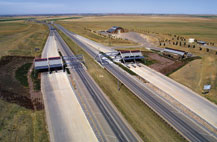 |
| Denvers E-470 toll road is overcoming a tough beginning and now handles 75,000 vehicles a day. |
The first modern-era toll road, financed entirely by $20.6 million in bonds, opened in Maine in 1947. Revenue bonding allows the Turnpike Authority to pledge back the debt via toll revenue and through no other state assets.
In the new century, states such as Texas are taking toll road trends to new levels. Variable priced lanes, increased private-sector involvement in both construction and operation and evolving high-speed, hands off toll collection systems will change the look and feel of future toll roads.
Toll authorities exist, or will exist, in all but a handful of states, says Keith Rosbury, senior vice president of HNTB Corp., Kansas City. Although "plain vanilla" toll roads are the current majority, that is rapidly changing, he adds. Variable priced lanes, or High Occupancy Toll (HOT) lanes, are moving payers along in Orange County, Calif., while in San Diego, a new toll road on I-15 charges lone automobile drivers wanting to use the fast lane.
|
Technology-wise, the U.S. is not anywhere near Europe, where some tolling authorities are experimenting with satellite-guided toll tracking, Rosbury says. But for roadbuilders, that factor will be increasingly important as they bid. "In the past, you primarily had separate contractors for systems integration, plus general contractors building the road," notes Jack Finn, national director of toll services for HNTB. But in the future, more roadbuilders will have the systems technology expertise on their team or within their firm, he predicts.
The market is flourishing, but methods vary. "If you ask six or seven people about toll roads, you can get six or seven descriptions," says Larry Shaw, executive vice president of business development for infrastructure at the Washington Group, Boise. The firm is involved with design for San Diegos SR 125 and finishing up the last eight miles of the 47-mile E-470 toll road in Denvera controversial specimen that after a rocky start now serves 75,000 drivers daily.
Shaw points to Georgia, Florida and Texas as hot spots for future toll road construction. "As states run into severe fiscal crunches, the pay-as-you-go infrastructure is more attractive," he says. Private firms "can act as a bridge between getting started on construction and the funding that will be available in the future to states." That depends, of course, on private firms ability to extract profits from toll roads.
Lessons remain to be learned from previous toll projects. Orange County, Calif., bought back SR 91 from the private consortium that built it in order to get out of the contract stipulation against building competing freeways (ENR 2/4/02 p. 14). That presents future challenges for contractual options in private-public partnerships.
Another lesson learned is that it is easier to toll new highways than reinstitute tolls on roads that abandoned them. Moreover, "in many cases the elected officials are more apprehensive about new toll roads than the general citizenry," says Rosbury. "Part of our responsibility as an industry is to educate elected officials."
New technology also will increase acceptance of tolls. "Public perception" of waiting at toll booths is an issue, notes Finn. "Technology is capable of reading your toll tag at 100 miles an hour," and though that speed obviously isnt encouraged, toll booth geometry can be configured to let vehicles drive through at the speed limit, he says.

Post a comment to this article
Report Abusive Comment